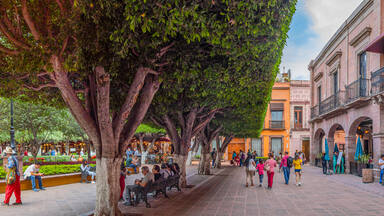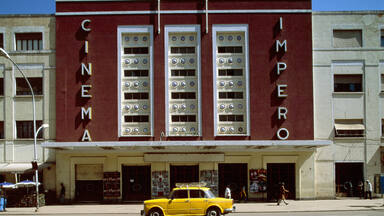"The Stone Town of Zanzibar is a fine example of the Swahili coastal trading towns of East Africa. It retains its urban fabric and townscape virtually intact and contains many fine buildings that reflect its particular culture, which has brought together and homogenized disparate elements of the cultures of Africa, the Arab region, India, and Europe over more than a millennium."
Historic building attributes
Although the overall urban fabric and townscape give Stone Town its unique character, many individual buildings of historical and architectural significance represent local architecture and building traditions. Typical building types include Swahili courtyard houses, narrow Indian shopfronts along bazaar streets, and large mansions facing the seafront.
"The continuity of traditional uses of most of the buildings in the historic town as residential and commercial space maintains the town as an important administrative and economic centre of the archipelago."
Most of Stone Town's buildings are dedicated to commercial and residential uses and follow basic construction techniques used along the East African coast for many centuries. The most commonly seen building materials are coral rag masonry set in thick lime, earth, and sand mortar, covered with lime plaster and lime wash.
In addition, buildings in Stone Town showcase distinct elements such as particularly well-recognized across Zanzibar wooden carved doors, elaborate balconies with intricate fretwork, and crenellated parapet walls surrounding flat terrace roofs.
Diversity in Building Traditions
"The individual buildings in Stone Town manifest, through their structure, construction materials and techniques, the interchange and influence of the different cultures around the Indian Ocean rim."
The distinct tradition of wattle and daub construction with thatched roofs of palm leaves, found on the East African coast, was overwhelmed by the rapid growth and immigration in the nineteenth century. Today, the building design in Stone Town reflects a complex fusion of materials, techniques, and elements from Arab, Indian, and European cultures while still retaining its indigenous features, creating a unique urban environment in Stone Town.
Arab influence
In the early 19th century, the Omanis arrived in Zanzibar as traders and later plantation owners. They introduced the massively built, multistory square block of coral stones and mortar with flat roofs and crenellated parapets. Although a relatively simple design, Omani houses featured intricately curved square wooden doors with patterns and motifs rich in symbolism. This type of housing included an interior courtyard reflecting Arabic beliefs and providing privacy for the residents.
Indian influence
Typologically and functionally, the largest class of traditional structures of Stone Town are the narrow shop-front houses along the bazaar streets derived from Indian traders. Their simple four-leaf Gujarat-style doors exposed the whole front of their houses to the customers, while the domestic quarters were hidden at the back of the house. The Indian influence brought into Stone Town haveli spacious houses of the Gujarati region, with carved verandas, intricate fascia boards, and windows with coloured glass lintels, creating highly ornamental facades, in comparison to Arab houses featuring simple external wall design. As trade activities became more profitable, many Omani houses were bought by Indian merchants and transformed by introducing external verandas. Indian architectural influence is also pronounced in Hindu temples present in the town.
British influence
At the beginning of the twentieth century, Zanzibar was a British Protectorate. During that time, Saracenic or Moorish features borrowed from Istanbul and Morocco were introduced in Stone Town, along with a few examples of churches and cathedrals inspired by these seen across Europe.
Monumental architecture
The influence of diverse cultures and religions is well exemplified in the monumental architecture of Stone Town. The major buildings date from the 18th and 19th centuries and include monuments such as the Old Fort; the House of Wonder, a large ceremonial palace built by Sultan Barghash; the Old Dispensary; St. Joseph’s Roman Catholic Cathedral; Christ Church Anglican Cathedral; the residence of the slave trader Tippu Tip; the Malindi Bamnara Mosque; the Jamat Khan built for the Ismaili sect; the Royal Cemetery; the Hamamni and other Persian baths.
-
Old Fort
stands on the ruined Portuguese Church and residential quarters, which had been converted by the Arabs into the fort for the use of the town garrison.
-
The House of Wonders
was built by Sultan Barghash in 1883 from a design of a British Marine Engineer for ceremonial purposes. It was among the first buildings in East Africa to be installed with electricity and tap water
-
Old Dispensary
was built by an Indian architect in 1887 and is an example of a typical building with Indian decor.
-
Roman Catholic Cathedral (St. Josephs’)
-
Anglican Cathedral
is standing on the site of the last open slave market to be open in Zanzibar. It is a monument to commemorate the history of the official abolition of the slave trade in Stone Town.
-
Tip house
is an example of a vernacular Arab townhouse representing changes in the built form common to the development of Zanzibar Town.
-
Malindi Bamnara Mosque
is one of the few mosques with a minaret, built in 1831.
-
Jamat Khan
is a religious building constructed in 1907, displaying massive stone pillars with exquisite carved capitals.
-
Royal Cemetery
is the half-finished tomb holding the remains of the Royal Family.
-
Persian baths
Hamamni is one of the two Persian-style baths in the Stone Town. It is one of Zanzibar's largest and best-preserved historic monuments built for public use.
Attributes of urban elements
The overall intact urban fabric and character of buildings assemblage is what gives the Stone Town its unique character of narrow, winding street patterns, clusters of low-rising buildings, and large mansions facing the seafront.
Narrow Streets
During the early time of settlement, different migrant groups tended to form subdivisions reflected in the urban pattern, developing clusters of interrelated buildings and courtyards. The interjacent land became a no man’s land’ of swindling paths and alleys, uncovering unexpected vistas behind every corner.
Open and built-up area
Another unique feature of Stone Town is the relationship between open and built-up areas. In Stone Town, open space tends to be domesticated rather than exposed. Individually, this is achieved by enclosing an open courtyard within a house. Communally, it is done by encompassing open spaces around buildings. This is demonstrated in the town’s layout. The two-story houses, with long, narrow rooms around an open courtyard, reached through a narrow corridor and were distinguished externally by elaborately carved double doors and, in some cases, wide verandahs. With the simple ground floor Swahili houses and the narrow façade, Indian shops along bazaar streets are constructed around a commercial space duka.
Moreover, Stone Town possesses streetscape elements, including old tombs, stairways, fountains, trees and vistas, graveyards, parks, and other green areas.
Baraza: the social edge of the street
With its high density and narrow streets, Stone Town has a limited number of public spaces, which are reduced to private courtyards. Hence, the streets and squares of Stone Town are typically lined with barazas and low masonry plinths at the base of the building walls. The baraza is part of the building's access stairs but also serves as a space for commerce and socializing.
Interactive mapping
Use the interactive mapping tool to explore the different layers that compose Cordoba's urban heritage. Browse through the tabs to explore the city's different scales and the attributes of its urban heritage identity. Expand the legend at the bottom right corner to discover more. Click on the areas and icons to open pop-ups and learn more about the different elements.
Attributes of the wider setting of the city or settlement
The Stone Town of Zanzibar forms a unique urban settlement due to a combination of historical but equally geographical circumstances. Zanzibar, the largest surviving Swahili town along the East African shore, was built on an ancient coral reef on the coast of Unguja Island, the main island of the Zanzibar Archipelago.
Beyond its historical significance, Stone Town is a thriving commercial and socio-cultural hub for the Zanzibar Archipelago. Encompassing 125 hectares, its conservation area includes the built-up section, open areas along the eastern border, and the older part of Darajani Street—constituting over half of the total municipality's area. The authenticity of Stone Town in its setting is vulnerable to the inappropriate scale and design of new developments in the property and its buffer zone, traffic issues, and pressures from the developing tourism industry.
Stone Town is an old part of Zanzibar, while a more recently developed portion of the city is referred to as Ng' ambo, meaning 'the other side' in the Swahili language.
Ng’ambo
The historic centre of the capital includes two neighbourhoods called a historic town - Stone Town, located on a promontory on the western side of the island, and the other side of the town - Ng ’ambo. The two areas were originally separated by a creek, filled at the start of the 19th century when today’s Ng‘ambo’s area was dedicated to the construction of several public buildings and accommodated less privileged classes pushed out from the Town.
Today, Stone Town forms the core of the World Heritage Site while the Ng ’ambo area forms its buffer zone.
Through the lens of the Historic Urban Landscape approach, Ng’ambo becomes an enhancement layer for the social and economic dynamism of the City Centre.
Intangible heritage values
Zanzibar has great symbolic importance in the suppression of slavery since it was one of the main slave-trading ports in East Africa. Stone Town is also marked as the site where slave trading was finally terminated.
"Stone Town bears the memory of all the slaves sold in Zanzibar as well as the memory of European explorers […]. Stone Town is, therefore, an outstanding tangible and intangible manifestation of these interactions through several millennia."
References
- Bianca, Stefano & Francesco Siravo. Zanzibar: A Plan for the Historic Stone Town. Geneva: The Aga Khan Trust for Culture. (1996). CC BY-NC 4.0 via Archnet
- ICOMOS. (2000). Advisory Body Evaluation. https://whc.unesco.org/document/152896
- Aalund F. (1993). Zanzibar, Old Stone Town. Monumentum. https://www.icomos.org/public/monumentum/vol26-2/vol26-2_6.pdf
- Ng ’ambo Atlas: Historic Urban Landscape of Zanzibar Town’s ‘Other Side.’ (2018). Department of Urban and Rural Planning, Zanzibar, African Architecture Matters.
- World Heritage Nomination Documentation Dossier, 173Rev. (1999). https://whc.unesco.org/uploads/nominations/173rev.pdf







